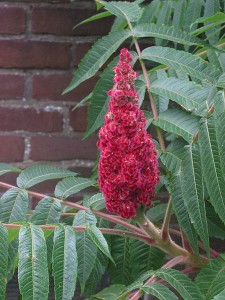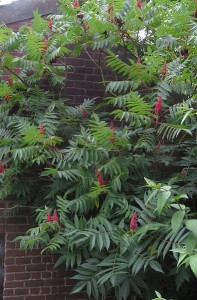
The first thing we think about when we hear the word sumac is the dreaded poison sumac. Just to clarify, the Sumac we are speaking of here is in the Genus: Rhus, the poison sumac is in the Genus Toxidendron, with Poison Ivy and Poison Oak. To make matters more confusing Poison Ivy, Oak and Sumac used to be considered to be in the genus Rhus with the non-poisonous Sumacs, but all that has been straightened out and currently the non-poisonous Sumacs are in the genus Rhus and the skin irritating plants are in the genus Toxidendron. Either way, all these plants are in the same family, but so are mangos, cashews and pistachios. The Sumacs(Genus: Rhus) are a genus of plants native to North America and other parts of the world, there are many species, two of the more common species that apply to this article are Staghorn sumac(Rhus typhina) and Smooth Sumac(Rhus glabra).
Edibility and Culinary Use

The fruits of this plant are edible, but only really enjoyable if prepared properly. These small berries are used to make a drink called native american Lemonade, the name makes sense since the plant is native to North America. The first step is to collect one or two bunches of the ripened fruits, which are available in late summer to early fall, you will know they are ripe because of their maroon color. There are different ways to prepare the drink but my favorite way is to fill a pitcher with cold water and just stick the fruit bunches in, and let it sit for an hour or 2, you can even let it sit in the fridge. See our staghorn sumac tea recipe for more detail. As the name “Lemonade” implies the fruits have a sour taste which will transfer to the water the longer it sits. It is better to use cold or room temperature water because hot water will bring out the tannins from the fruits and add a bitter taste. The berries have also been used to add flavor to pies.
Health Benefits
Sumac is an ancient medicinal plant. Modern day studies have shown that sumac is antimicrobial. This is probably one reason sumac has been used to treat sore throats. Like many wild medicinal and wild edible plants sumac also has antioxidant properties. Another unique medicinal property of sumac is that it has hypoglycemic properties, which means that it lowers blood sugar which could help people with some conditions like hyperglycemia. Like many other tart or sour tasting foods, this plant also contains Vitamin C.
Cautions
Edible Sumac is in the same family as Poison Sumac, Poison Ivy and Poison Oak. Some people who have very sensitive skin may have an allergic reaction, this is also known to occur in other plants in this family like mangos and cashews. Another thing to watch out for is that sometimes they are loaded with small grubs on the inside of the berry cluster. The way to avoid this is to pick them right when they turn ripe, but I don’t worry about them, they probably add more nutrition to the drink anyways.
Conclusion
A great way to make a healthy lemonade-like drink is to use Sumac Berries. It really makes a great tasting drink. Ripe Sumac berries are easy to spot since they are dark maroon and stick up at the top of the plant. They ripen in late summer which is good because it’s a refreshing thing to have on a hot day.
Many of our readers find that subscribing to Eat The Planet is the best way to make sure they don't miss any of our valuable information about wild edibles.
See our privacy policy for more information about ads on this site







3 Responses
Thanks!
I would like to try it. It sounds simple enough!
I’ve been living in Rotterdam for the past 35 years and have often seen these plants (trees) here for so many years. They grow in clusters and make excellent shade trees. I never knew the name so I had no idea as to the history or the various uses of the plant until recently. It’s mid July now and the tree in my gardened has already blossomed so I’ll have to wait til next year to try the recipe. Thanks for the information.
I’m trying to brew some since reading this.